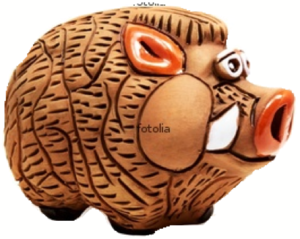Piggy Bank
| Piggy Bank (Porkius Moneyholdius) | |
|---|---|
| A piggy bank in captivity | |
| Kingdom | Animalia |
| Phylum | Chordata |
| Class | Mammalia |
| Order | Porkus |
| Family | Plasticus |
| Genus | Usefulness |
| Species | ''P. Moneyholdius'' |
| Conservation Status | Extinct in the wild, common in captivity
|
A piggy bank, or simply, piggy, (Porkius Moneyholdius) is a primitive species of the toy family, belonging to the Porkus family. Resembling a pig, it is common to most households and has an unusual diet of coins and notes. They rang from simple clay pink specimens to plastic, disposable piggies.
Natural habitat[edit | edit source]
The piggy bank is extinct in the wild and a genetic mutation is now kept in captivity, in zoos and most commonly as pets. Some piggies have been dumped and have become feral, but most have not survived, being run over by cars, eaten by superior predators like dogs and cats, and from not being able to find food. Piggies are very dependant on their owners and although many campaigns have been made to release piggies into the wild, all have failed. The piggies are usually to be found hiding in dark corners in shelves, or in drawers and behind books. They have a knack of hiding in the most unthinkable places, driving their owners crazy.
Breeding[edit | edit source]
The breeding habits of the Piggy Bank are strange and mysterious, and have never been documented. Nowadays piggies are not allowed to mate with eachother and are instead cloned in large numbers at factories, from where they are shipped out and sold. Many groups have been formed to stop this, as the piggies are treated to horrible, confined conditions, are not given any food until they are bought by owners. Piggies who are never bought will either starve or be thrown in the trash where they will be crushed.
Behavior[edit | edit source]
Piggy banks are solitary, slow animals and do not move much, preferring to move around and hide while by themselves. Because of this, Piggy bank movement is not seen very much. This is because they are very shy, as in their natural habitat they were hunted very often by money-hungry businessmen.
The Piggy bank's diet consists primarily of money, usually coins, but many have been found to feed on less valuable objects when in need. Amazingly, the piggy bank can store money in it's belly for months on end, and only release the food when wanted, or if it's belly is full. Because of this, many owners are using the Piggy banks as money storage depots - they would feed the piggy's the money and then, when the money was needed, they would force the pig to remove the money.
The Piggy bank has been recorded to hurt and even kill some humans, by balancing somewhere high, (usually a shelf or bookcase) and as a human would walk by, they would drop and land on their head, causing the human considerable pain. Likewise, many piggy deaths have been recorded from toddlers who have grabbed them and dropped them. Once again, considerable pain for the piggy's part. Most piggies, however, have died from being dumped by unwanted owners. This has greatly reduced the population of these animals at times.
Physiology[edit | edit source]
Piggy banks range in size, but mostly are less then 20cm and more then 10cm in length. They are commonly colored pink but exotic varieties have been cloned to be a range of colors and patterns, while others have skin made out of different materials. In this case, most of the piggies have smooth clay skin, while others are made out of cheaper and weaker plastic, with engravings. It is thought that these colors and markings were originally used to attract mates, but as nothing is truly known about the breeding habits of this species, this can not be confirmed.
Piggy banks are commonly round and plump, to fit all those coins in. They have short, stubby legs, a large nose, beady eyes and short twirly tail. Their round bodies and short, stumpy legs slow their speed, and although this is a disadvantage, they do not move in human presence, as mentioned in the behaviour section. Newly cloned Piggies have featured a slit on their back, so in stead of feeding the coins to the piggie you simply drop them through the slit, and then open a closed hole in their belly to release the coins. Once again, many groups have been greatly against this, but cloning companies have remained firm and have continued the cruelty. Many groups are disgusted by this, and at one point Piggy bank breeder's sales fell into a steady decline because of this.



